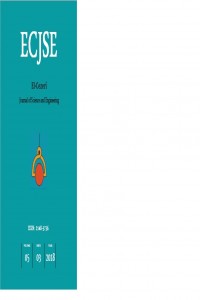Öz
Bu çalışmada, -20 mikron
boyutundaki kuvars taneleri ile belirli katı oranında hazırlanan atıksu
numuneleri üzerinde anyonik, katyonik, noniyonik (iyonlaşmayan) flokülantlar
kullanılarak tanelerin çökelme davranışları incelenmiş; flokülant tipi ve
miktarının flokülasyon üzerine etkileri belirlenmiştir. Daha sonra katı oranı
ve tane boyutunun etkisini belirlemek için farklı katı oranlarında ve tane
boyutlarında hazırlanan numuneler üzerinde flokülantlar arasında en iyi sonucu
veren anyonik flokülant kullanılarak flokülasyon deneyleri yapılmıştır. Deneysel
çalışmalarda 0.06 mg/L dozajında anyonik flokülant (SPP 508) kullanılması ile
çöktürme sonunda elde edilen temizlenmiş suyun en düşük bulanıklık değeri;
başlangıç bulanıklık değeri olan 210 NTU’dan 9.6 NTU’ya düşürülmüştür. Aynı
zamanda katı oranının artması ile gerekli optimum flokülant dozajının arttığı;
tane boyutunun artmasının ise flokülasyon başarısını olumlu yönde etkilediği
tespit edilmiştir.
Anahtar Kelimeler
Kaynakça
- [1] İPEKOĞLU, Ü, “Susuzlandırma ve Yöntemleri”, Dokuz Eylül Üniversitesi, Mühendislik Fakültesi Yayınları No: 179, 1997.
- [2] GERGORY, J., “Particles in water: Properties and Process”, University College London, 2005.
- [3] TRIPATHY T., RANJAN DE B., “Flocculation: A New Way to Treat the Waste Water”, Journal of Physical Sciences, 10, 93–127, 2006.
- [4] HOGG R., “Flocculation and dewatering”, International Journal of Mineral Processing, V:58, 223-236, 2000.
- [5] ROSA, J.J, AND RUBİO, J, “The FF (flocculation–flotation) process”, Minerals Engineering. 18,701-707, 2005.
- [6] SOMASUNDARAN P., KRISHNAKUMAR S., “Adsorption of surfactants and polymers at the solid-liquid interface”, Colloids Surfaces A: Physicochemical and Engineering Aspects, 491–513, 1997.
- [7] ERSOY, B, “Mermer işleme tesisi atık su arıtımında kullanılan flokülantların tanıtımı”, Türkiye IV. Mermer Sempozyumu, s. 449-462, 2003.
- [8] PEARSE, M.J., WEIR S., ADKINS S.J AND MOODY G.M., 2001, “Advances in mineral flocculation”, Mineral Engineering, 14, 1505-1511.
- [9] PEARSE, M.J., “Historical use and future development of chemicals for solid–liquid separation in the mineral processing industry”, Minerals Engineering, V: 16, 103–108, 2003.
- [10] SABAH, E., ACIKSOZ, C., “Flocculation Performance of Fine Particles in Travertine Slime Suspension”, Physicochemical Problems of Mineral Processing 48(2), 555–566, 2012.
- [11] BESRA L., SENGUPTA D.K., ROY S.K., “Particle characteristics and their influence on dewatering of kaolin, calcite and quartz suspensions”, Int. J. Miner. Process. 59, 89–112, 2000.
- [12] MPOFU P., ADDAI-MENSAH J., RALSTON J., “Investigation of the effect of polymer structure type on flocculation, rheology and dewatering behavior of kaolinite dispersions”, Int. J. Miner. Process. 71, 247–268, 2003.
- [13] ROSSINI, M., GARRIDO J., GARCIA, GALLUZZO, M.,” Optimization of the coagulation flocculation treatment influence of rapid mix parameters”, Wat. Res., 33, 8: 1817–1826, 1999.
- [14] CENGIZ I., SABAH E., OZGEN S., AKYILDIZ H., “Flocculation of Fine Particles in Ceramic Wastewater Using New Types of Polymeric Flocculants”, Journal of Applied Polymer Science, 112, 1258–1264, 2009.
- [15] ERSOY, B., “Effect of pH and Polymer Charge Density on Settling Rate and Turbidity of Natural Stone Suspensions”, International Journal of Mineral Processing, 75, 207– 216, 2005.
- [16] GREGORY J., GUIBAI L., “Effects of dosing and mixing conditions on polymer flocculation of concentrated suspensions”, Chemical Engineering Communications, V: 108, 3–21, 1991.
- [17] ÖZKAN A., UÇBEYIAY H., DÜZYOL S., “Comparison of stages in oil agglomeration process of quartz with sodium oleate in the presence of Ca (II) and Mg(II) ions,” Journal of Colloid and Interface Science, vol. 329, pp. 81-89, 2009.
- [18] HENDERSON J.M., WHEATLEY A.D, “Factors Affecting the efficient flocculation of tailings by Polyacrylamides”, Coal Preparation, 1987, V 4, 1-49, 2007.
- [19] BAŞARAN H. K., TAŞDEMİR T., “Determination of Flocculation Characteristics of Natural Stone Powder Suspensions in the Presence of Different Polymers”, Physicochem. Probl. Miner. Process., 50(1), 169−184, 2014.
- [20] TAŞDEMIR T., KURAMA H., “Fine Particle Removal from Natural Stone Processing Effluent by Flocculation”, Environmental Progress & Sustainable Energy, Vol. 32, No. 2, 317–324, 2012.
- [21] TAŞDEMİR, T., ERDEM V., “Flokülasyon yöntemi ile atıksudan askıda tanelerin giderimi”, Eskişehir Osmangazi Üniversitesi Mühendislik Mimarlık Fakültesi Dergisi, Cilt:XXIII, Sayı:1, 109-121, 2010.
- [22] OWEN A.T., FAWELL P.D., SWİFT D.M., LABBETT D.M., BENN F.A., FARROW J.B., “Using turbulent pipe flow to the study the factors affecting polymer-bridging flocculation of mineral systems”, ınternational Journal of Mineral Processing, 87, pp 90-99, 2008.
- [23] MİSHRA K.P., GUPTA K.D., TRİPATHY P.S.M., SİNGH N.M., “Effect of variation of particle size and agitation on the flocculation of coals by polymeric flocculants”, J. Indian Chem. Soc., 73 (4-5), 223, 1996.
- [24] TAŞDEMİR T. and TAŞDEMİR A., “Some factors affecting flocculation properties of fine quartz particles”, III International Conference on Engineering and Natural Sciences, pp 114, 2017.
Ayrıntılar
| Birincil Dil | Türkçe |
|---|---|
| Konular | Mühendislik |
| Bölüm | Makaleler |
| Yazarlar | |
| Yayımlanma Tarihi | 30 Eylül 2018 |
| Gönderilme Tarihi | 16 Mayıs 2018 |
| Kabul Tarihi | 4 Temmuz 2018 |
| Yayımlandığı Sayı | Yıl 2018 Cilt: 5 Sayı: 3 |



